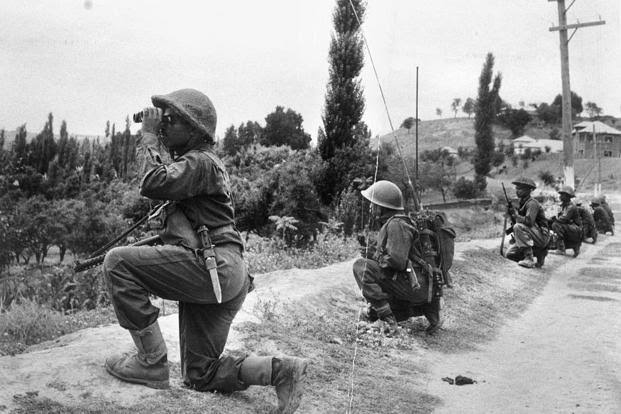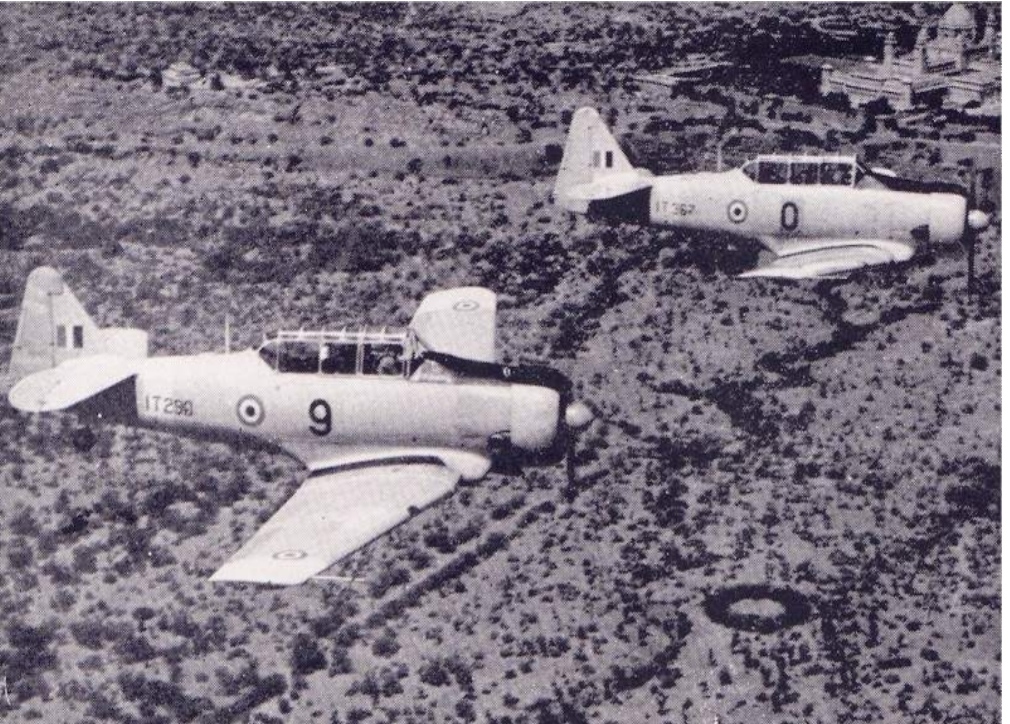Jodhpur and the 1965 Indo Pak War

by Flt Lt K Ahmed Shah (Retd)
Jodhpur was the most bombed Indian City of the Indo-Pak 1965 war. More than two hundred thousand pounds of bombs were dropped in and around the Air Force Base. Though the targets were military installations there was no direct hit on any building or runway. Bomb shrapnel broke into the main offices and Hangars causing minor damage.
Most of the glass panes in the HQ building were shattered and some ear-drums damaged.
I was posted to Air Force Flying College, Jodhpur as an Instructor in November 1962, after our country had got into a Border Conflict with the Chinese; it was referred to as The Chinese Aggression.
It was later even called The Himalayan Blunder. At this time the country and Air Force discovered that we were very short of pilots to fly even if helpful countries gifted us war planes.
Hence, started the concerted efforts of producing trained pilots at our own training units and even with training abroad. At Jodhpur and other training establishments we worked our butts off to produce them by the thousand.
Quite often instructors flew more than 100 hrs a month. With three to four courses passing through each year, I was told that in two years we produced more pilots than the Air Force had in its entire life.
Came 1965 and war clouds started gathering. The Kutch trouble made us move all our training aircraft to Bidar. We brought them back to Jodhpur when the situation improved.
Other problems with aggressive designs of Pakistan and fears of infiltrators put us on guard to prepare and protect ourselves with whatever resources were available. All the training ac were flown out to Bidar again; others were dispersed around the airfield and in pens. It dawned on the higher-ups later that Training Units should not be so close to our borders. Jodhpur was virtually defenseless without intercepting ac and without any anti-aircraft guns.
Instructors who were qualified on other frontline ac were attached out to their respective squadrons to join the war effort. Besides HT2 and Harvard trainers, Jodhpur had Dakotas at NAV School (Sqn Ldr CA Nicholas) and Vampires with Signal School (Fg Offrs Sassoon and Fg Offr Clark were flying them). I was a rare person to be qualified on all these four types.
There were a few of us Instructors qualified on Vampires who formed the “120 Squadron” with these Vampires. Sqn Ldr JR Balraj was the CO and Sqn Ldr SP (Bundle) Tyagi (his nephew – also an SP “Bundle” Tyagi, went on to become Air Chief Marshal) was the Flt Cdr. I got my opportunity to get back on the Vamps. It was thrilling to practice Dummy dives on an old disused Dakota parked at Salawas satellite airfield; to do low flying at tree top height and land without any landing lights at night : only a bit of moon light.
Jodhpur airfield was a staging post for our Canberra ac flying on to Pak targets. The runway, therefore, became the target for the B-57 PAF bombers. On one occasion, one of our Canberra fully loaded with bombs got bogged down and it was a target and a big scare. We had no ack ack guns. When the bombing started, our Vamps did their best in the dark to intercept the enemy ac with the help of our Radar unit. We had no luck as the enemy ac could not be spotted even when the blips merged on the radar screen. Landing back on the runway which itself was the target became dangerous.
An anti-aircraft unit with L-40 guns was quickly positioned around our airfield. They started firing a barrage of tracer shells at an imaginary enemy aircraft. The Vamps couldn’t thereafter fly in the same sky.
It was a great sight watching the tracers and hearing the deafening sound of the bombs exploding. It was funny to see a soldier trying to use some sort of aid to both his ears and looking towards the sound of the enemy ac with the sole purpose of directing the ack ack guns towards the enemy aircraft.
The PAF pilots were quite clever as they throttled back the engines (so that they won’t be detected by sound) and dived towards their target Runway, dropped their bombs before speeding away.
Despite all those tracers in the sky not one bullet found its target. But we were lucky that no bomb landed on any of our Runways. We got news that an L-70 unit in the North was very successful with their Radar tracking guns and had brought down a few enemy aircraft.
 A pair of North American Harvard trainers belonging to the AFTC over Jodhpur airfield. The Umaid Bhavan can be seen in the background.
A pair of North American Harvard trainers belonging to the AFTC over Jodhpur airfield. The Umaid Bhavan can be seen in the background.
The Vampire aircraft were used in the North on the first strike at the enemy tanks. The excited pilots lingered over the target and were pounced on by enemy Sabres and a couple of them were shot down. There after the Vamps were pulled out.
Clearance was obtained to use our Vampire aircraft for strike/strafing sorties over enemy territory which fell marginally in our Radius of Action. One aircraft returned with bullet holes made by ground fire. One aircraft while returning, escaped detection by Sabres who were strafing Uttarlai airfield. One squadron Pilot (Sqn Ldr Inder Parmar) was awarded the Vir Chakra for destroying an enemy aircraft and troops on the ground.
The pilots also had to man the Base Ops and it was essential to know when an enemy aircraft was approaching our airfield so that the siren can be switched on for warning personnel to take shelter in the trenches. Our Radar was unable to detect these low flying enemy aircraft.
They would be flying low following the Railway Line and difficult to detect. However our sirens usually went ON sufficiently early to take protective action thanks to a Railway Station Master who used to telephone us every time a low flying ac was heard going past his station.
If we were not bombed we used to warn Jamnagar which would have become the target. We used to get many calls from people who used to think that all high flying satellites were enemy ac. We always checked if noise was heard or the ac was flying low.
I often wondered why these enemy aircraft did not consider doing what they did in broad daylight instead of only by night.
Maybe they mistakenly thought that the small blips by our Vampires were those of IAF GNAT aircraft which knocked down quite a few of the Pak aircraft; poor intelligence? On one occasion when returning home I noticed a crowd of civilians counting 3 visiting Hunter aircraft going round the field to burn out fuel before landing.
I heard one of them watching the orbiting ac and counting “……14, 15, 16….”. This sort of information might have put the scare into our enemies. Wingco Clark brought some Hunters over to Jodhpur. By then the bombing had stopped.
The quality of bravery of the enemy bomber pilots suddenly changed. They started dumping their bombs anywhere as soon as our guns opened up and fled. No longer did we see them coming through the barrage of our anti-aircraft guns, engines idling, bombing and going away or repeating their attacks.
Bombs fell on the golf course and other civilian spots damaging private property and killing civilians. A prison hospital with surrounding walls was hit directly and many prisoners were buried alive in their trenches as the blast was concentrated due to the surrounding high wall. A cyclist on the outside of the same prison wall survived. Many new bunkers (golf hazards?) were created by PAF bombs on the Golf course!
One day an unexploded bomb was brought in a cart by farmers to the Collector who hastily ran out of his office and had the bomb squad handle the situation.
One bomb hit the edge of the Sardar Club (Golf) building and had its tail unit dislodged. It did not explode. The Club was intact. However the bomb squad detonated it as usual where it lay after covering it with sand bags. Half the Club building and the roof blew away.
I went there and found my Golf set standing in one corner of the roofless building. I had to brave it and get it out from there by myself, though it was risky! Thankfully none of the partly standing building fell on me. A building visible from the Golf course had a crack from top to bottom which looked like a streak of lightening.
Pak propaganda claimed to have bombed the Jodhpur Air Force Mess killing about 60 pilots. They always made such statements when it had happened to them. We checked after the war with Air Chief Arjan Singh if we had done similar damage. He said that on one of our raids, we had hit a briefing room causing many casualties to their pilots. Maybe they were the missing brave attackers of Jodhpur.
We had night patrols by our personnel to protect our areas due to the threat of infiltrators. Air Force airmen were not adept at handling guns. An unsafe Sten gun accidentally fired into the back of their night patrol leader, sending my friend Bobby Shamdas to the hospital, where he succumbed to his injuries. We even had one patrol shoot at another thinking they were enemy infiltrators.
Imagination played tricks at the mess also when an officer shot towards an imaginary infiltrator which turned out to be paint spilled on the club wall. We once had our ack ack guns shoot at our aircraft taking off at dawn – luckily he missed Sqn Ldr Mike Gurney in the Vampire.
I once spent a long time in the trench waiting for the bombing. One of our visiting Officers, Flt Lt Peter Brown (the 6ft 4inch pilot who could not fit into our HT-2 Basic Trainer and had to fly on Harvards only), had trained on the Sabre ac in the U.S. He was wishing aloud if he could only hijack one Sabre from the enemy. Waiting for the bombs and feeling hungry, it was thrilling to run into the empty mess kitchen and bring out a few cutlets to eat before the bombs fell. Peter who migrated to Australia did mention in our recent communication that we were the lucky survivors of the Jodhpur bombing. Having encountered this bombing onslaught, I mentioned at one of our Club meetings in Madras that the civilians in the South will not be able to appreciate the work of our Services unless they had heard a bomb going off near them. No Diwali cracker can produce such a loud noise or cause such fearful tremors and sensations of death that bombs can produce when they are exploding around you. Many bomb craters were dangerously close to our trenches near the HQ building.
For me 1965 in Jodhpur was a significant and memorable experience. Like all wars this one also took its toll. I lost a dear friend and another was taken prisoner. Thankfully, the latter returned in one piece, though he was treated badly.
Flt Lt K Ahmed Shah joined the Indian Air Force as an Auxillary Air Force commission. He served in the IAF for just over a period of ten years from 1956 to 1966. This is his story of being stationed AFS Jodhpur.
Source : Bharat Rakshak




